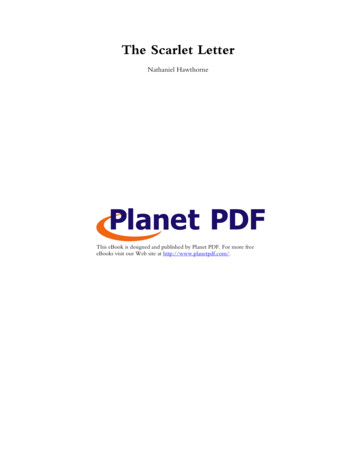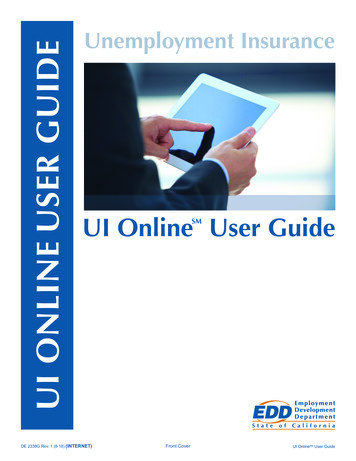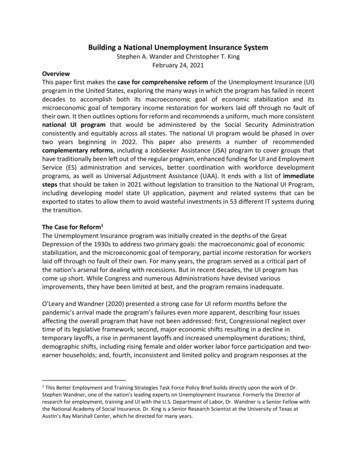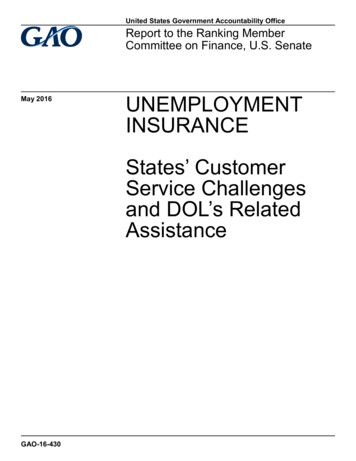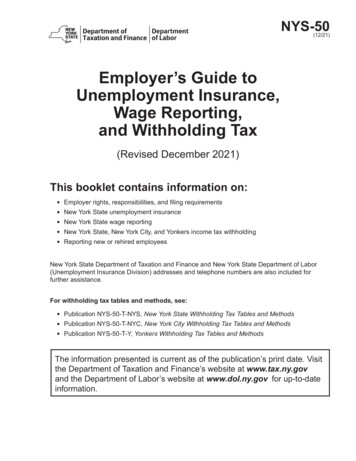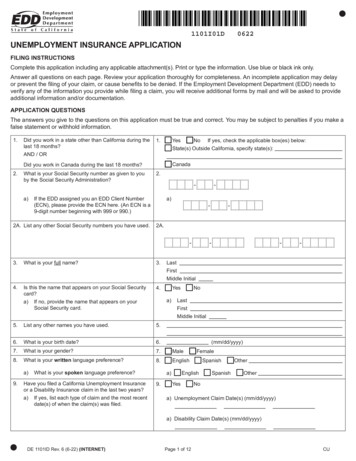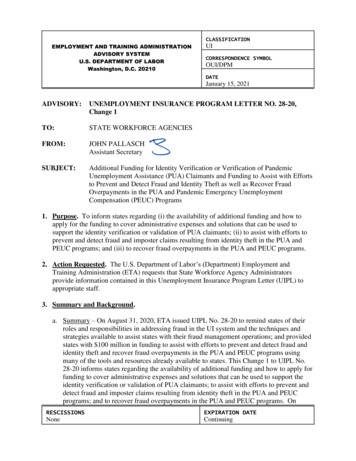
Transcription
CLASSIFICATIONEMPLOYMENT AND TRAINING ADMINISTRATIONADVISORY SYSTEMU.S. DEPARTMENT OF LABORWashington, D.C. 20210UICORRESPONDENCE SYMBOLOUI/DPMDATEJanuary 15, 2021ADVISORY:UNEMPLOYMENT INSURANCE PROGRAM LETTER NO. 28-20,Change 1TO:STATE WORKFORCE AGENCIESFROM:JOHN PALLASCHAssistant SecretarySUBJECT:Additional Funding for Identity Verification or Verification of PandemicUnemployment Assistance (PUA) Claimants and Funding to Assist with Effortsto Prevent and Detect Fraud and Identity Theft as well as Recover FraudOverpayments in the PUA and Pandemic Emergency UnemploymentCompensation (PEUC) Programs1. Purpose. To inform states regarding (i) the availability of additional funding and how toapply for the funding to cover administrative expenses and solutions that can be used tosupport the identity verification or validation of PUA claimants; (ii) to assist with efforts toprevent and detect fraud and imposter claims resulting from identity theft in the PUA andPEUC programs; and (iii) to recover fraud overpayments in the PUA and PEUC programs.2. Action Requested. The U.S. Department of Labor’s (Department) Employment andTraining Administration (ETA) requests that State Workforce Agency Administratorsprovide information contained in this Unemployment Insurance Program Letter (UIPL) toappropriate staff.3. Summary and Background.a. Summary – On August 31, 2020, ETA issued UIPL No. 28-20 to remind states of theirroles and responsibilities in addressing fraud in the UI system and the techniques andstrategies available to assist states with their fraud management operations; and providedstates with 100 million in funding to assist with efforts to prevent and detect fraud andidentity theft and recover fraud overpayments in the PUA and PEUC programs usingmany of the tools and resources already available to states. This Change 1 to UIPL No.28-20 informs states regarding the availability of additional funding and how to apply forfunding to cover administrative expenses and solutions that can be used to support theidentity verification or validation of PUA claimants; to assist with efforts to prevent anddetect fraud and imposter claims resulting from identity theft in the PUA and PEUCprograms; and to recover fraud overpayments in the PUA and PEUC programs. OnRESCISSIONSEXPIRATION DATENoneContinuing
December 27, 2020, the President signed the Consolidated Appropriations Act, 2021,Public Law (Pub. L. 116-260), which includes in Division N, Title II, Subtitle A, theContinued Assistance for Unemployed Workers Act of 2020 (Continued Assistance Act).For states to have an adequate system for administering the PUA program, Section 242 ofthe Continued Assistance Act requires that states include procedures for identityverification or validation and for timely payment, to the extent reasonable andpracticable, by January 26, 2021 (30 days after the enactment of the ContinuedAssistance Act).b. Background – Since the enactment of the Coronavirus Aid, Relief, and EconomicSecurity (CARES) Act of 2020, which created several new temporary unemploymentcompensation (UC) programs (including PUA and PEUC), UI fraud has increasedsignificantly, further testing the integrity of individual state systems and the UI programas a whole. Since the unprecedented increase in claims resulting from the economicimpact of the Coronavirus Disease 2019 (COVID-19) pandemic, UI programs havebecome a target for fraud with states experiencing a significant amount of imposterclaims filed with stolen or false identities. The Unemployment Insurance FraudProtection Guide issued by the U.S. Department of Justice on September 21, 2020,states: “Fraudsters, some of which are transnational criminal organizations, are usingstolen identities of U.S. citizens to open accounts and file fraudulent claims for UIBenefits, exploiting the unprecedented expansion of these benefits provided in responseto economic disruption caused by the COVID-19 pandemic.”Addressing improper payments and fraud remains a top priority for the Department andthe entire UI system. It is critical that states implement UI programs and provisions toensure that payments are being made to eligible individuals and that states haveaggressive strategies and tools in place to prevent, detect, and recover fraudulentpayments, with a particular emphasis on imposter fraud by claimants using falseidentities.The programs and provisions within the Continued Assistance Act, the EmergencyUnemployment Insurance Stabilization and Access Act, and the CARES Act operate intandem with the fundamental eligibility requirements of the Federal-State UI program.These requirements include that an individual file certification with respect to eachweek of unemployment paid and be able and available and actively seeking work whereapplicable, except as specifically provided for in statute. In addition, the ContinuedAssistance Act includes new program integrity requirements for the PUA and PEUCprograms with which states must comply.Some states remain in the midst of managing extraordinary workloads due to the effectsof the spread of COVID-19. During this time, there is a heightened need for states tomaintain a steadfast focus on UI functions and activities that ensure program integrityand the prevention and detection of improper payments and fraud across all programsoperated within the UI system. UIPL No. 23-20, published on May 11, 2020, alsodiscusses program integrity for the UI system.2
States play a fundamental role in ensuring the integrity of the UI system. While stateshave been provided some flexibilities as a result of the COVID-19 pandemic, thoseflexibilities are generally limited to emergency temporary actions as needed to respondto the spread of COVID-19. States must ensure that individuals only receive benefits inaccordance with federal and state law.ETA strongly encourages states to utilize the tools, resources, and services of the UIIntegrity Center, funded by the Department and operated in partnership with the NationalAssociation of State Workforce Agencies. One of the UI Integrity Center’s key assets tosupport addressing fraud is the Integrity Data Hub (IDH), which includes a variety ofdata sets to prevent and detect fraud based on identity theft at the time of application,including an identity verification solution. ETA also encourages states to consult withthe UI Integrity Center on data analytics, to prioritize IDH cross-matches and risk scoringresults, and to explore other tools and solutions available through the private sector thatcomplement the IDH. Refer to Training and Employment Notice (TEN) No. 4-20 fordetails.The IDH is a secure, robust, centralized, multi-state data system that allows participatingstate UI agencies to submit claims for cross-matching and analysis to support theprevention and detection of improper payments, fraud, and identity theft. The IDHcontains an expanded set of data sources and new functionality continues to be exploredand added. Currently the IDH offers the following capabilities: Suspicious Actor Repository (SAR);Suspicious E-Mail Domains;Foreign IP Address Detection;Multi State Cross-Match (MSCM);Data Analytics;Fraud Alert System; andIdentity Verification (IDV).The IDH is available to participating states at no cost and is an effective tool inpreventing and detecting improper payments and combatting imposter fraud and identitytheft. Additionally, in UIPL No. 28-20, the Department explained its expectation thatstates connect to the IDH no later than March 31, 2021, and encouraged states to use theirshare of the funding provided through that UIPL to support IDH connection as soon aspossible.In addition to implementing the IDH’s IDV solution, states are encouraged to use thesefunds to implement other identity verification processes/procedures or tools tocomplement the IDV solution. States may also use these funds for other identityverification tools, processes, or procedures available on the market to support the identityverification or validation of PUA claimants as required in the Continued Assistance Act.Because the Pacific territories (Guam, American Samoa, the Commonwealth of theNorthern Mariana Islands, the Federated States of Micronesia, the Republic of the3
Marshall Islands, and the Republic of Palau) do not have access to the IDH, ETA willprovide targeted technical assistance to the Pacific territories to assist with theexploration of solutions, processes, and procedures to support the identity verification orvalidation of PUA claimants and to identify options available to support enhanced fraudprevention and detection.The Department’s Office of the Inspector General (OIG)/Office of Investigations – LaborRacketeering and Fraud, Department of Justice, and other federal, state, and local lawenforcement agencies investigate and prosecute fraud and identity theft. In addition,financial institutions and banks have ramped up their efforts to stop fraudulent payoutsand detect fraudulent activity as a result of their own data analytics. It is critical for statesto engage appropriate law enforcement agencies as soon as emerging and identified fraudschemes are detected, as well as to be proactive in working collaboratively with financialinstitutions and banks to detect fraud and recover overpayments. State Benefit PaymentControl (BPC) staff or other designated state staff have the primary responsibility forthese activities.Finally, fraud detection, operations, and procedures, coupled with front-end identityverification tools, are critical in ensuring payment is made timely and only to individualsentitled to receive benefits. As discussed in UIPL Nos. 23-20 and 28-20, the Departmentstrongly encourages states to adopt multiple strategies and techniques to validate UIclaims and detect and share suspicious claim attributes between states, and consider arange of other tools available in the market when combating fraud and ensuring programintegrity.4. Funding for States to Address Fraud in the PUA and PEUC Programs. Section 242 ofthe Continued Assistance Act requires states to have an adequate system for administeringthe PUA program including procedures for identity verification or validation and for timelypayment, to the extent reasonable and practicable, for claims filed on or after January 26,2021. As part of its ongoing monitoring efforts of state implementation of the CARES Actprograms, ETA will ensure states have adequate procedures in place to meet thisrequirement.To assist states with administrative expenses and solutions that can be used to support theidentity verification of PUA claimants, and the need for states to have additional funding tosupport ongoing and new fraud prevention, detection, and investigation activities, theDepartment is providing an additional 100 million in administrative funding targetedspecifically at addressing fraud and identity theft in the PUA and PEUC programs as part ofits responsibility to provide “such sums as necessary” for administration of the CARESAct programs.Attachment I, State Size Classifications and Funding Allocation for IdentityVerification of Pandemic Unemployment Assistance (PUA) Claimants and Funding toAssist with Efforts to Prevent and Detect Fraud and Identity Theft as well as RecoverFraud Overpayments in the PUA and Pandemic Emergency UnemploymentCompensation (PEUC) Programs, lists the amounts of PUA and PEUC funding for4
each state provided for assistance with PUA identity verification or validation and forPUA and PEUC fraud investigation activities.The methodology for state funding levels is based on state size.1 For purposes of thismethodology, states are assigned to three groups (Small, Medium, and Large) based onthe 12-month average of UI covered employment for the four quarters in calendar year2019 reported on the ES 202 (Employment, Wages and Contributions) report publishedby the Bureau of Labor Statistics. States are assigned to the size groups as follows: Small: covered employment under 1 million employees Medium: covered employment between 1 million and 2 million employees Large: covered employment greater than 2 million employeesa. Use of Funds. States may use the funds made available under this UIPL to coveradministrative expenses and solutions that can be used to support the identityverification or validation of PUA claimants; to assist with efforts to prevent and detectfraud and imposter claims resulting from identity theft in the PUA and PEUC programs;and to recover fraud overpayments in the PUA and PEUC programs. Examples ofpermissible uses of these funds include but are not limited to:(i) Implement one or more tool(s)/strategy(ies) providing the front-end identityverification or validation of PUA claimants as required in Section 242 of theContinued Assistance Act.States may fulfill the new requirement to verify or validate the identity of PUAclaimants by implementing the IDV solution available through the UI IntegrityCenter’s IDH or an equivalent tool and may use funds provided to cover anyadministrative costs associated with establishing the IDV connection. The IDH’sIDV solution is provided at no cost to the states. The IDH’s IDV solution providescentralized identity verification, powered by Experian’s Precise ID solution. TheIDV component offers states advanced fraud risk scoring to maximize front-endidentity verification, enabling states to assess whether an individual is using a false,stolen, or synthetic identity.In addition to implementing the IDH’s IDV solution, states are encouraged to usethese funds to implement other identity verification processes/procedures or tools tocomplement the IDV solution. States may also use these funds for other identityverification tools, processes, or procedures available on the market to support theidentity verification or validation of PUA claimants as required in the ContinuedAssistance Act.1The Pacific territories are included in PUA pursuant to CARES Act Section 2101(a)(5), but not in PEUC.Since the Pacific territories have relatively small populations and do not operate regular UI programs (andtherefore lack data on employment), their PUA funding is based on estimated claims workloads.5
(ii) Staff or contract services to conduct fraud investigations and other fraud and identitytheft detection-related activities, or to implement tools to increase prevention,detection, and recovery of fraudulent improper payments in the PUA and PEUCprograms. Examples of activities that these funds may be used for include, but arenot limited to: Funding for staff to conduct fraud prevention, detection, and investigationactivities. Accessing and utilizing the private or public data sets available through the IDH(see Section 3(b) above for IDH details). As indicated in UIPL No. 28-20, ETAexpects that all states will be positioned to use the IDH data sets as soon asadministratively feasible, and no later than March 31, 2021. Implementing data mining tools, including the use of staff or contractorservices for prioritizing and managing cross-match hits, and conductingdata mining activities. Implementing software/tools to conduct data analytics, including the use ofstaff or contractor services for conducting data analytics activities.b. Application Instructions.States are required to submit an SF-424 for each funding allotment (i.e., one SF-424 forthe PUA funding and a second SF-424 for the PEUC funding). ETA encourages states tosubmit these forms as soon as possible, but no later than February 15, 2021, byelectronic submission to the National Office at covid-19@dol.gov, with a copy to theappropriate ETA Regional Office.For additional information on completing the SF-424, please refer to Attachment II,Instructions for Completing the SF-424. Attachment I, State Size Classifications andFunding Allocation for Identity Verification of Pandemic Unemployment Assistance(PUA) Claimants and Funding to Assist with Efforts to Prevent and Detect Fraud andIdentity Theft as well as Recover Fraud Overpayments in the PUA and PandemicEmergency Unemployment Compensation (PEUC) Programs, which lists the fundingallotment(s) for both the PUA and PEUC programs for each state.c. Reporting Requirements.States will report quarterly progress on the form ETA 9178-F that will be used by ETA totrack each state’s progress on activities and ensure that a state’s use of funds is consistentwith the permissible activities outlined in section 4.a. of this UIPL. Please refer toAttachment III in UIPL No. 28-20 for instructions for completion and the timeline ofsubmission for the ETA 9178-F.5. Inquiries. States should direct inquiries to covid-19@dol.gov and copy the appropriate ETARegional Office.6. References. Consolidated Appropriations Act, 2021, including Division N, Title II, Subtitle A,the Continued Assistance for Unemployed Workers Act of 2020 (Pub. L. 116-260);6
Coronavirus Aid, Relief, and Economic Security (CARES) Act (Pub. L. 116-136),Title II, Subtitle A – Relief for Workers Affected by Coronavirus Act;Families First Coronavirus Response Act (Pub. L. 116-127), including Division DEmergency Unemployment Insurance Stabilization and Access Act of 2020(EUISAA);Section 303 of the Social Security Act (42 U.S.C. 503);Unemployment Insurance Program Letter (UIPL) No. 9-21, Continued Assistance forUnemployed Workers Act of 2020 (Continued Assistance Act) – Summary of KeyUnemployment Insurance (UI) Provisions, issued December 30, 2020,https://wdr.doleta.gov/directives/corr doc.cfm?DOCN 3831;UIPL No. 28-20, Addressing Fraud in the Unemployment Insurance (UI) System andProviding States with Funding to Assist with Efforts to Prevent and Detect Fraud andIdentity Theft and Recover Fraud Overpayments in the Pandemic UnemploymentAssistance (PUA) and Pandemic Emergency Unemployment Compensation (PEUC)Programs, issued August 31, 2020,https://wdr.doleta.gov/directives/corr doc.cfm?DOCN 8044;UIPL No. 23-20, Program Integrity for the Unemployment Insurance (UI) Programand the UI Programs Authorized by the Coronavirus Aid, Relief, and EconomicSecurity (CARES) Act of 2020 - Federal Pandemic Unemployment Compensation(FPUC), Pandemic Unemployment Assistance (PUA), and Pandemic EmergencyUnemployment Compensation (PEUC) Programs, issued May 11, 2020,https://wdr.doleta.gov/directives/corr doc.cfm?DOCN 4621;UIPL No. 16-20, Coronavirus Aid, Relief, and Economic Security (CARES) Act of2020 – Pandemic Unemployment Assistance (PUA) Program Operating, Financial,and Reporting Instructions, issued April 5, 2020,https://wdr.doleta.gov/directives/corr doc.cfm?DOCN 4628;UIPL No. 16-20, Change 1, Coronavirus Aid, Relief, and Economic Security(CARES) Act of 2020 – Pandemic Unemployment Assistance (PUA) ProgramReporting Instructions and Questions and Answers, issued April 27, 2020,https://wdr.doleta.gov/directives/corr doc.cfm?DOCN 5899;UIPL No. 16-20, Change 2, Coronavirus Aid, Relief, and Economic Security(CARES) Act of 2020 - Pandemic Unemployment Assistance (PUA) AdditionalQuestions and Answers, issued July 21, 2020,https://wdr.doleta.gov/directives/corr doc.cfm?DOCN 5479;UIPL No. 16-20, Change 3, Coronavirus Aid, Relief, and Economic Security(CARES) Act of 2020 - Eligibility of Individuals who are Caregivers for PandemicUnemployment Assistance (PUA) in the Context of School Systems Reopening, issuedAugust 27, 2020, https://wdr.doleta.gov/directives/corr doc.cfm?DOCN 3849;UIPL No. 16-20, Change 4, Continued Assistance to Unemployed Workers Act of2020 —Pandemic Unemployment Assistance (PUA) Program: New OperatingInstructions and Reporting Changes, issued January 8, 2021,https://wdr.doleta.gov/directives/corr doc.cfm?DOCN 6973;UIPL No. 01-16, Federal Requirements to Protect Individual Rights in StateUnemployment Compensation Overpayment Prevention and Recovery Procedures,issued October 1, 2015, https://wdr.doleta.gov/directives/corr doc.cfm?DOCN 5763;7
UIPL No. 01-16, Change 1, Federal Requirements to Protect Claimant Rights inState Unemployment Compensation Overpayment Prevention and RecoveryProcedures - Questions and Answers, issued January 13, 2017,https://wdr.doleta.gov/directives/corr doc.cfm?DOCN 7706;UIPL No. 19-11, National Effort to Reduce Improper Payments in the UnemploymentInsurance (UI) Program, issued June 10, 2011,https://wdr.doleta.gov/directives/corr doc.cfm?DOCN 3036;UIPL No. 29-05, Memorandum of Understanding Regarding UnemploymentInsurance Criminal Investigations Between the U.S. Department of Labor’s Office ofInspector General and the Employment and Training Administration, issued August2, 2005, https://wdr.doleta.gov/directives/corr doc.cfm?DOCN 2104;UIPL No. 04-01, Payment of Compensation and Timeliness of Determinations duringa Continued Claims Series, issued October 27, 2000,https://wdr.doleta.gov/directives/corr doc.cfm?DOCN 1746;TEN No. 3-20, Unemployment Insurance (UI) Integrity Center’s Integrity Data Hub(IDH) Fraud Alert System, issued August 31, 2020,https://wdr.doleta.gov/directives/corr doc.cfm?DOCN 5585;TEN No. 4-20, Encouragement for States to Use the Integrity Data Hub (IDH)available through the Unemployment Insurance (UI) Integrity Center, issued August31, 2020, https://wdr.doleta.gov/directives/corr doc.cfm?DOCN 3588; andEmployment Security Manual, Section 7511, The Secretary’s Interpretation ofFederal Law Requirements, available at 20 C.F.R. Part 614, Appendix C, Standardfor Fraud and Overpayment Detection.7. Attachment(s). Attachment I: State Size Classifications and Funding Allocation for IdentityVerification of Pandemic Unemployment Assistance (PUA) Claimants and toAssist with Efforts to Prevent and Detect Fraud and Identity Theft as well asRecover Fraud Overpayments in the PUA and Pandemic EmergencyUnemployment Compensation (PEUC) Programs Attachment II: Instructions for Completing the SF-4248
Attachment I to UIPL No. 28-20, Change 1State Size Classifications and Funding Allocationfor Identity Verification of Pandemic Unemployment Assistance (PUA) Claimants andFunding to Assist with Efforts to Prevent and Detect Fraud and Identity Theft as well asRecover Fraud Overpayments in the PUA and Pandemic Emergency UnemploymentCompensation (PEUC) ProgramsStateSize iaColoradoConnecticutDelawareDistrict of kaNevadaNew HampshireNew JerseyNew MexicoNew YorkNorth CarolinaNorth DakotaOhioOklahomaOregonPennsylvaniaPuerto RicoRhode IslandSouth ssistance (PUA)Funding Allotment 1,499,400 1,020,600 2,041,200 1,499,400 2,041,200 2,041,200 1,499,400 1,020,600 1,020,600 2,041,200 2,041,200 1,020,600 1,020,600 2,041,200 2,041,200 1,499,400 1,499,400 1,499,400 1,499,400 1,020,600 2,041,200 2,041,200 2,041,200 2,041,200 1,499,400 2,041,200 1,020,600 1,020,600 1,499,400 1,020,600 2,041,200 1,020,600 2,041,200 2,041,200 1,020,600 2,041,200 1,499,400 1,499,400 2,041,200 1,020,600 1,020,600 ion(PEUC) FundingAllotment 285,600 194,400 388,800 285,600 388,800 388,800 285,600 194,400 194,400 388,800 388,800 194,400 194,400 388,800 388,800 285,600 285,600 285,600 285,600 194,400 388,800 388,800 388,800 388,800 285,600 388,800 194,400 194,400 285,600 194,400 388,800 194,400 388,800 388,800 194,400 388,800 285,600 285,600 388,800 194,400 194,400 388,800
StateSize ClassificationSouth DakotaTennesseeTexasUtahVermontVirgin IslandsVirginiaWashingtonWest ymentAssistance (PUA)Funding Allotment 1,020,600 2,041,200 2,041,200 1,499,400 1,020,600 1,020,600 2,041,200 2,041,200 1,020,600 2,041,200 1,020,600 83,311,200Pacific TerritoriesAmerican SamoaCommonwealth of the Northern Mariana IslandsFederated States of MicronesiaGuamPalauRepublic of Marshall IslandsTOTALI-2PandemicUnemploymentAssistance (PUA)Funding Allotment 100,000 210,000 100,000 210,000 100,000 100,000 EUC) FundingAllotment 194,400 388,800 388,800 285,600 194,400 194,400 388,800 388,800 194,400 388,800 194,400 15,868,800
Attachment II to UIPL No. 28-20, Change 1Instructions for Completing the SF-424Please note that States are required to submit an SF-424 for each funding allotment (i.e.one SF-424 for the Pandemic Unemployment Assistance funding; and a second SF-424 forthe Pandemic Emergency Unemployment Compensation funding).I. Application for Federal Assistance (SF-424)Use the current version of the form for submission. Expired forms will not beaccepted. SF-424, Expiration Date 12/31/2022, Office of Management andBudget (OMB) Control No. 4040-0004 s/sf-424- family.htmlSection # 8, APPLICANT INFORMATION: Legal Name: The legal name must match the name submitted with the System forAward Management (SAM). Please refer to instructions athttps://www.sam.gov/SAM/. Employer/Tax Identification Number (EIN/TIN): Input your correct 9-digit EIN andensure that it is recorded within SAM. Organizational DUNS: All applicants for Federal grant and funding opportunities arerequired to have a 9-digit Data Universal Numbering System (D-U-N-S ) number,and must supply their D-U-N-S number on the SF-424. Please ensure that yourstate is registered with the SAM. Instructions for registering with SAM can be foundat https://www.sam.gov/SAM/. Additionally, the state must maintain an active SAMregistration with current information at all times during which it has an active Federalaward or an application under consideration. To remain registered in the SAMdatabase after the initial registration, there is a requirement to review and update theregistration at least every 12 months from the date of initial registration orsubsequently update the information in the SAM database to ensure it is current,accurate, and complete. Failure to register with SAM and maintain an active accountwill result in a rejection of your submission. Address: Input your complete address including Zipcode 4; Example: 20110-831.For lookup, use link at tion. Organizational Unit: Input appropriate Department Name and Division Name, ifapplicable. Name and contact information of person to be contacted on matters involving thisapplication. Provide complete and accurate contact information including telephonenumber and email address for the point of contact.II-1
Section # 9, Type of Applicant 1: Select Applicant Type: Input “State Government”.Section # 10, Name of the Federal Agency: Input “Employment and TrainingAdministration”.Section # 11, Catalog of Federal Domestic Assistance Number: Input“17.225”; CFDA Title: Input “Unemployment Insurance”.Section # 12, Funding Opportunity Number and Title: For Pandemic Unemployment Assistance Funding Allotment: Input “UIPL No. 2820, Change 1, Pandemic Unemployment Assistance – Claimant Identity Verificationand Fraud Investigation Activities Grants”. For Pandemic Emergency Unemployment Compensation Funding Allotment: Input“UIPL No. 28-20, Change 1, Pandemic Emergency Unemployment Compensation Fraud Investigation Activities Grants”.Section # 13, Competition Identification Number: Leave Blank.Section # 14, Areas Affected by Project: Input the place of performance for the projectimplementation; Example “NY” for New York.Section # 15, Descriptive Title of Applicant’s Project: For Pandemic Unemployment Assistance Funding Allotment: Input “UIPL No. 2820, Change 1, Pandemic Unemployment Assistance - Claimant Identity Verificationand Fraud Investigation Activities Grants”. For Pandemic Emergency Unemployment Compensation Funding Allotment: Input“UIPL No. 28-20, Change 1, Pandemic Emergency Unemployment Compensation Fraud Investigation Activities Grants”.Section # 16, Congressional Districts of:a. Applicant: Input the Congressional District of your home office. For lookup, uselink at www.house.gov with Zipcode 4.b. Program/Project: Input the Congressional District where the project work isperformed. If it is the same place as your home office, input the congressionaldistrict for your home office. For lookup, use link at www.house.gov withZipcode 4.Section # 17, Proposed Projecta. Start Date: Input a valid start date for the project (earliest start date will beJanuary 1, 2021).b. End Date: Input a valid end date for the project (June 30, 2022).II-2
Section # 18, Estimated Funding ( ):Input the applicable funding allotment for each of the programs as listed for your state inAttachment I.Section #s 19 – 20: Complete as per instructions for Form SF-424.Section # 21, Authorized Representative: Please select the “I AGREE” check box andprovide complete information for your authorized signatory including contactinformation such as telephone number and email address. If your AuthorizedRepresentative has changed from your previous application submission for this program,please include a letter from higher-level leadership authorizing the new signatory for theapplication submission.Remember to have the SF-424 signed and dated by the Authorized Representative.II-3
prevent and detect fraud and imposter claims resulting from identity theft in the PUA and PEUC programs; and (iii) to recover fraud overpayments in the PUA and PEUC programs. 2. Action Requested. The U.S. Department of Labor's (Department) Employment and Training Administration (ETA) requests that State Workforce Agency Administrators
